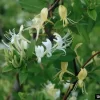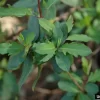X
CONTACT US
Great Lakes Center, SAMC 319
SUNY Buffalo State
1300 Elmwood Ave., Buffalo, NY 14222
wnyprism@buffalostate.edu
(716) 878.4708
SUBSCRIBE TO LISTSERV
FOLLOW US
CONTACT

Japanese honeysuckle is a woody, perennial vine that can both trail and climb. Photo credit: Chris Evans, University of Illinois, Bugwood.org.
Japanese Honeysuckle
COMMON NAME:
Japanese HoneysuckleSCIENTIFIC NAME:
Lonicera japonicaORIGIN:
East AsiaDESCRIPTION:
Japanese honeysuckle is a woody, perennial vine that can both trail and climb, reaching heights of up to 80 feet. Most of its leaves are simple, oval, and opposite, but the lowermost leaves may have rounded lobes. Its white-pink flowers occur in pairs between leaves in late spring and continue to bloom throughout the summer, eventually fading to yellow. Flowers give way to black fruits that mature in the fall.HABITAT:
This species favors disturbed areas and margins including roadsides, field edges, floodplains and forest openings. It tolerates shade and prefers moist soils.THREAT:
Climbing Japanese honeysuckle grows over shrubs and trees, eventually causing them to collapse under the additional weight or girdle the supporting tree. Trailing vines form a dense monoculture that prevents the germination and recruitment of other native plants and diminishes biodiversity.MANAGEMENT:
Small infestations can be removed manually, but care must be taken to ensure all root fragments are removed to prevent resprouting. Larger infestations can be controlled chemically in late fall, when the Japanese honeysuckle still has its leaves but most native species have already lost theirs.
WNY PRISM PRIORITY:
WNY PRISM Priority
Tier 3 - Containment
ADDITIONAL RESOURCES:
Additional Resources:
University of Florida Institute of Agricultural and Food Sciences
Texas Invasive Species Institute
Maine Department of Agriculture, Conservation and Forestry
NYS Prohibited and Regulated Species - Part 575:
PATHWAYS OF INVASION:
Pathways
Japanese honeysuckle was originally introduced in the 1800s as an ornamental plant and later for erosion control. Established populations can spread vegetatively, through contaminated soil and by birds who can spread seeds long distances.
Japanese honeysuckle is a prohibited species in New York State - for more information on Prohibited and Regulated Species, visit http://www.dec.ny.gov/animals/99141.html.
REGIONAL DISTRIBUTION:
Regional Distribution
Unknown





